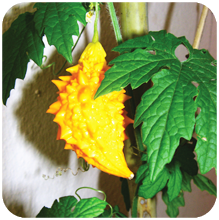
Momordica Charantia is a tropical and subtropical plant of the family Cucurbitaceae, widely found in Asia, Africa, Caribbean, cultivated for edible fruits that are very bitter in taste. This herbaceous plant grows to 5 m. Plant has simple leaves, 4-12 cm diameter alternate with three to seven deep separated lobes. Each plant has separate male and female flowers of yellow color.
Fruit (used for medicinal purposes) has a distinct warty exterior and an oblong shape. It is empty in cross-section with a relatively thin layer of pulp surrounding the central cavity filled with large flat seeds, and pulp. The fruits are often eaten fresh, or when starting to turn yellow. At this stage, the pulp is crunchy and watery in texture, similar to cucumber or green bell pepper, but bitter in taste. The skin of the fruit is tender and edible.
Chemical composition – The fruit containing glycosides, saponins, alkaloids, sugars, resins, phenolic constituents, fixed oil and free acids. It contains alkaloids, charantin, Charin, cryptoxanthin, cucurbitin, cucurbitacin, cucurbitane, cycloartenol, diosgenin, elaeostearic acids, erythradiol, galacturonic acids, gentisic acid, goyagycoside, goyasaponine inhibitors of guanylate cyclase, gypsogenin, hydroxytryptamine, karounidiol, lanosterol, lauric acid, linoleic acid, linolenic acid, momorcharaside, momorcharine, momordenol, momordiciline, momordicine, momordicinine, momordicoside, momordin, momordolo, multiflorenol, myristic acid, nerolidol, oleanolic acid, oleic acid, oxalic acid, pentadecane, peptides, petroselinic acid, polypeptide, protein, ribosome inactivating proteins, rosmarinic acid, rubixanthin, spinasterol, steroidal glycosides, stigmastadioles, stigmasterol, taraxerol, trechalose, trypsin inhibitors, uracil, vacin, v-insulin verbascoside, vicinie, zeatine, riboside, zeaxanthin, amino acids, aspartic zeinoxanthin acid, serine, glutamic acid, alanine, gamma-amino butyric acid and pipecolic, ascorbigen, b-sitosterol-d-glucoside, citrulline, elasterol, flavochrome, lutein, lycopene, pipecolic acid. Fruits and seeds of Momordica charantia have a polypeptide-p-insulin, which is considered similar to bovine insulin.
Properties – Diabetes, anthelmintic, antibacterial, antibiotic, anti-inflammatory, antimicrobial, anti-leukemic, antimutagenic, antimycobacterial, antioxidant, antitumor, antiulcer, antiviral, aphrodisiac, astringent, carminative, cytostatic, cytotoxic, depurative, hypocholesterolemic, hypotensive, hypotriglyceridemic, hypoglycemic, immunostimulant, insecticidal, galactagog, laxative, purgative, stomachic, styptic, tonic, vermifuge.
Recommendation – Diabetes, colds, constipation, digestion, demulcent, dermatitis, diarrhea, dyspepsia, eczema, fevers, hemorrhoids, hepatitis, inflammation (liver), leprosy, leucorrhoea, leukemia, malaria, menstrual cramps, pain, itching, rheumatism, scabies, vaginitis, glycosuria, halitosis, hematuria, polyuria, anemia, colitis, kidney stones, sterility (female), dysentery, gonorrhea, anorexia, rhinitis, dysmenorrhea, gout, psoriasis, pain, asthma, headaches, burns, sprue, pain stomach, cold, cough, hypertension.
This plant is incorporated in natural remedy DAITAB.




